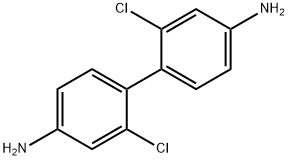3,3' -Dichlorobenzidine is barely discolored on exposure to air and is chemically resistant to water. Oxidizing agents, such as bromine water, potassium dichromate, and iron(III) chloride, cause the formation of a green color. With gold, the green color is still detectable at a dilution of 1 : 5000000. N-Acetyl-3,3' -dichlorobenzidine and N,N' - diacetyl-3,3' -dichlorobenzidine form when 3,3' - dichlorobenzidine is treated with acetic anhydride in dilute alcohol. The tetrazotizing behavior is similar to that of benzidine and o-tolidine.
4,4''-Diamino-2,2''-Dichlorobiphenyl is a useful reactant for the synthesis of benzidine, L-?proline, and diaminofluorene derivatives which are hepatitis C virus NS5A inhibitors.
3,3' -Dichlorobenzidine was introduced about 1932 and is now the most important diphenyl base. It is used as the starting material for pigments with yellow and red shades. These are used for coloring printing inks, paints, plastics, and rubbers. The important diarylide yellow pigments, which are incorrectly known as benzidine yellows, are formed by the combination of 3,3' - dichlorobenzidine with acetic acid arylides. 3,3' - Dichlorobenzidine is also used in the production of polyurethane rubbers.
3,3' -Dichlorobenzidine is made from o-nitro-chlorobenzene by reduction with zinc dust and sodium hydroxide solution and subsequent rearrangement with dilute hydrochloric acid or sulfuric acid. It is assayed by titration with sodium nitrite solution in dilute hydrochloric acid and detected in human urine by colorimetry using chloramine. The detection limit is 0.1 mg/kg.
2,2' -Dichlorobenzidine is made from m-nitrochlorobenzene, preferably using zinc dust and sodium hydroxide solution. It is subsequently rearranged and isolated in the form of a dihydrochloride.
It is almost insoluble in water but readily soluble in alcohol.
Crystallise the benzidine from EtOH or H2O. [Beilstein 13 H 234, 13 I 66, 13 II 106, 13 III 477, 13 IV 384.]
